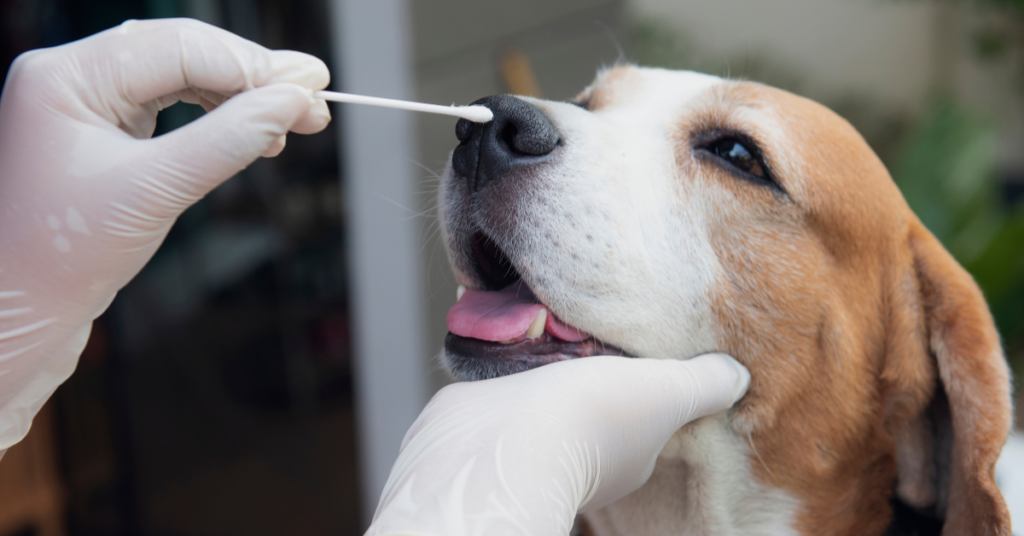One illness that has been gaining attention in recent years is the canine influenza. As responsible pet owners, it’s crucial to recognize potential health risks that could affect our furry companions. Much like the flu in humans, the dog flu can be uncomfortable and potentially dangerous if not addressed promptly. In this blog, we’ll discuss how to spot the early signs of canine influenza, as well as how to care for your dog if they catch the flu.
*Disclaimer: This Post May Contain Affiliate Links. This Means That I Receive A Small Commission At No Extra Cost To You Should You Click Through And Make A Purchase. Learn More On My Policy Page
What is Canine Influenza, and How is it Spread?
Canine influenza, or dog flu, is a contagious respiratory illness caused by specific strains of the influenza virus. There are two main strains that affect dogs: H3N8 and H3N2.
The H3N8 strain was first detected in greyhounds in 2004, while H3N2 originated in Asia and spread to the U.S. in 2015.
Dog flu spreads easily in areas where dogs come into close contact, such as dog parks, kennels, and groomers.
Your dog can contract the virus through direct contact with other infected dogs, contaminated surfaces, or respiratory droplets in the air.
The virus is highly contagious, so it’s important to know how to protect your dog if an outbreak occurs.
What Are the Symptoms of Canine Influenza?
Dog flu symptoms are similar to those seen in humans with the flu. If your dog starts showing any of the following signs, they might have contracted canine influenza:
- Coughing
- Sneezing
- Runny nose
- Watery eyes
- Lethargy
- Loss of appetite
- Fever
- Difficulty breathing (in more severe cases)
Dogs that exhibit these symptoms should be monitored closely. It’s essential to contact your veterinarian if your dog shows any signs of illness, especially if they’ve been around other dogs recently.
Can Dog Flu Be Serious?
While most cases of dog flu are mild, the disease can become severe in some dogs, especially those with weakened immune systems, young puppies, or older dogs.
In severe cases, complications such as pneumonia can develop, which can be life-threatening if not treated promptly.
If your dog experiences trouble breathing, persistent coughing, or becomes severely lethargic, it’s important to get them veterinary care right away. Early treatment can make a big difference in preventing complications.
How is Canine Influenza Diagnosed and Treated?

If you suspect your dog has the flu, a veterinarian can diagnose the illness through blood tests or nasal swabs to detect the virus.
There’s no specific antiviral treatment for canine influenza, but your vet can provide supportive care to help manage the symptoms. This might include:
- Fluids to prevent dehydration
- Rest and limiting activity
- Medications to reduce fever or cough
In more severe cases, antibiotics might be prescribed to treat secondary bacterial infections, such as pneumonia.
The key to helping your dog recover is providing a calm environment and following your vet’s care instructions.
Here are a few products that may be helpful if your dog has the flu:
- Immune System Support Supplements: Boost your dog’s immunity for better protection.
- Dog Crate for Isolation: Safely quarantine infected dogs during recovery.
- Dog Rehydration Electrolytes: Keep your dog hydrated during flu treatment.
- Digital Thermometers for Pets: Monitor your dog’s temperature for signs of fever.
How Can I Help My Dog Recover from the Flu?
If your dog has the flu, there are several ways you can support their recovery:
- Limit exposure to other pets: Isolate your dog to prevent the spread of the virus.
- Keep them hydrated: Ensure they have access to plenty of fresh water, as dehydration is a risk.
- Provide nutritious food: Offering high-quality, easily digestible food will help boost your dog’s immune system.
- Monitor their symptoms: Keep an eye on your dog’s symptoms and contact your vet if their condition worsens.
- Use a humidifier: This can help alleviate respiratory discomfort by adding moisture to the air.
Recovery times vary, but most dogs will begin to feel better within two to three weeks with proper care.
How Can I Prevent My Dog from Getting the Flu?

Prevention is always better than treatment. There are several steps you can take to reduce your dog’s risk of contracting canine influenza:
- Vaccinate: Ask your vet about the canine influenza vaccine, which protects against both H3N8 and H3N2 strains.
- Limit exposure: During flu outbreaks, avoid taking your dog to crowded places like dog parks, kennels, or grooming salons.
- Practice good hygiene: Wash your hands after handling other dogs, and avoid sharing water bowls or toys between pets.
These measures can significantly reduce the chances of your dog contracting or spreading the virus.
When Should I See a Vet if My Dog Has Flu Symptoms?
If your dog shows any symptoms of the flu, it’s always best to consult with your vet, especially if the symptoms persist for more than a few days or if your dog’s condition worsens.
Seek veterinary care immediately if your dog experiences:
- Labored breathing
- High fever
- Severe coughing
- Dehydration
- Loss of consciousness
Your vet will provide guidance on how to proceed with treatment and ensure your dog gets the help they need to recover.
Conclusion: Consult Your Vet if Your Dog Shows Flu Symptoms
Canine influenza is a serious concern, but with early detection and proper care, most dogs can make a full recovery.
Be mindful of any changes in your dog’s behavior and symptoms, and don’t hesitate to seek veterinary care.
Take action now: If your dog is showing signs of the flu, contact your vet for a diagnosis and treatment plan. It’s always better to be safe and ensure your dog gets the help they need.
For more information on canine flu check out this article from the Merck Veterinary Manual.
By staying informed and taking proactive measures, you can help protect your beloved pet from canine influenza and keep them healthy for years to come.
For more articles like this check out our Health and Wellness Page.













